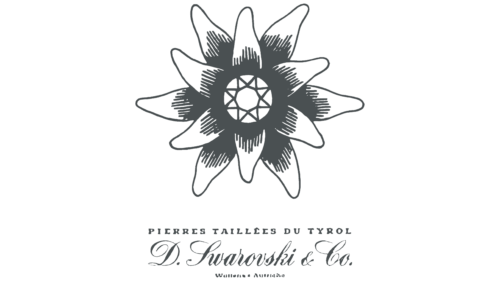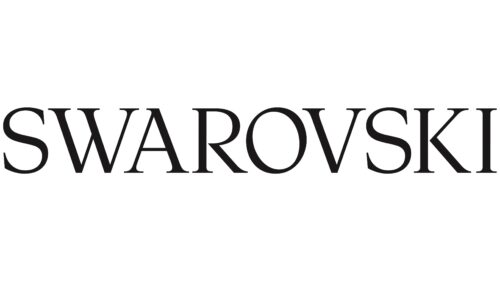The Swarovski logo embodies timeless beauty and eternal brilliance. The delicate, elegant lines of the emblem beautifully convey how the brand’s crystals can transform any piece into a true work of art. The company’s jewelry enhances and refines any look, highlighting the uniqueness and value of each item. Like the crystals, the emblem symbolizes elegance and high craftsmanship, making the brand renowned worldwide.
Swarovski: Brand overview
Daniel Swarovski was born in 1862 into a glassblower family in Bohemia, now part of the Czech Republic. This marked the beginning of Swarovski’s history. Daniel was interested in his father’s trade from an early age and wanted to advance the glass manufacturing method.
Daniel received a patent for an electric grinding machine for crystal manufacturing in 1892. This innovation transformed the market by making it possible to make premium crystals more quickly and precisely than ever before.
An important year for the business was 1895. In the small Tyrolean town of Wattens, Austria, Daniel Swarovski established “A. Kosmann, D. Swarovski & Co.” with business partners Armand Kosmann and Franz Weis. The hydroelectric power in the area was chosen since it is necessary to run the grinding machines.
The company’s early years were devoted to developing technologies for producing crystals. The manufacturer experimented with various compositions and processing techniques to achieve unparalleled purity and brilliance.
The fashion world swiftly adopted these crystals in the early 20th century. Their brilliant sparkle and superior quality drew the attention of designers and fashionistas, who utilized them to make jewelry and adorn apparel.
A significant milestone occurred in 1911 when Daniel’s sons joined the family business, guaranteeing its continued growth and stability.
The edelweiss blossom, which served as the company’s original emblem and represented the excellence and purity of its goods, was unveiled in 1919.
For the brand, the 1930s were a time of diversification. Under the Tyrolit name, the firm started manufacturing optical devices such as binoculars and telescopes. This is still a viable business venture today.
Despite a sharp decline in crystal output during World War II, the producer retained its core competencies and workforce.
Following the war in the 1950s, the company resumed active development. It started working with top fashion houses, improving its industry standing.
The first line of crystal figurines was introduced in 1976, which makes it noteworthy. These tiny sculptures quickly gained widespread popularity among collectors.
The Swarovski Crystal Society was founded in 1987 as a club for product collectors. Its goal was to foster fan communities and improve customer interactions.
“Swarovski Crystal Worlds” is a unique museum and exhibition space devoted to the art and history of crystals, which opened in Wattens in 1995.
In the 2000s, the company kept growing its influence on design and fashion. The business started making jewelry and accessory lines and aggressively collaborated with international designers and companies.
ATELIER SWAROVSKI, which offers unique collections made in association with top designers, made its debut in 2009.
The business introduced SWAROVSKI ELEMENTS in 2011 to cater to manufacturers and professional designers. This endeavor enhanced the company’s standing as a provider of crystals to the fashion and design industries.
In 2012, the firm increased its high-tech footprint. The company opened up new markets for its interior design and architecture products by introducing cutting-edge LED solutions that used crystals.
The brand commemorated its 120th anniversary in 2014 with a unique collection that embodied its inventive spirit and extensive history.
In 2015, a large amount of money was invested in digital technology. The business modernized its online store to increase consumer interaction and introduced several digital projects.
The company increased its market share in the luxury accessory sector in 2016 by launching a new watch line.
Atelier Swarovski Home, which featured home décor and furnishings made in association with well-known designers, debuted in 2017.
One of the most prominent fashion events, the Met Gala, is one of the events that the brand officially partnered with in 2018, further solidifying its position in the world of high fashion.
2019 the firm debuted its new retail model by launching a new flagship store on the Champs-Élysées in Paris.
Notwithstanding the world’s difficulties in 2020, the company innovated and unveiled a new line of crystals using cutting-edge technologies.
There were notable changes to the company’s leadership in 2021. In its 120-year history, the firm named Giovanna Engelbert as CEO, the first non-Swarovski family member to hold the position. This signaled the start of a new phase in the business’ growth.
In 2022, the company unveiled an updated corporate identity that reflected the brand’s contemporary outlook and included a new logo and visual style.
The product line will continue to grow in 2023, with additional jewelry and accessory lines targeted at a younger demographic.
The brand has been a family enterprise passed down from generation to generation. The business has grown from a tiny workshop to a world leader in manufacturing crystals while upholding its commitment to quality and innovation.
Meaning and History
What is Swarovski?
It is an Austrian luxury company known worldwide for its exquisite crystal products. The company sells various products known for their amazing brilliance and quality, such as jewelry, accessories, home decor, and figurines. Due to their exceptional brilliance, the brand’s crystals are highly valued and often used in jewelry, fashion, and other art forms. The company is known for its advanced crystal-cutting techniques and ability to combine classic craftsmanship with contemporary style. In addition to consumer products, the company also manufactures optical instruments and road safety products. Leading the crystal business, the company is present worldwide through partner stores, online platforms, and boutiques. The company’s products are popular with those seeking affordable luxury and often partner with fashion designers, artists, and stage and film productions.
1895 – 1988
The first Swarovski emblem reflects the period when Daniel Swarovski, the founder and inventor of crystals, led the company. The logo featured the brand’s name with an added “D” to denote his name—Daniel Swarovski. Above the name indicated the company’s production and location—”Pierres Taillées du Tyrol.” The abbreviation “Co” concealed the names of Swarovski’s partners—Armand Kosmann and Franz Weis.
The central element of the logo was the edelweiss flower, symbolizing Austria. This choice was not accidental—its uniqueness and beauty were associated with the purity and elegance for which the company’s crystals are known. Instead of the Edelweiss’s core, a crystal was placed in the logo, symbolizing preciousness and perfection as if bestowed by nature itself.
1988 – 2016
The logo introduced at the end of the 20th century symbolizes a new era for Swarovski. With its elegantly curved neck, the black swan became the brand’s emblem, reflecting its pursuit of perfection and elegance. This symbol emphasizes the grace and nobility inherent in the company’s products and represents continuous progress, like a swan gliding smoothly on the water’s surface. The swan’s wings, crafted from thousands of crystals, symbolize the company’s craftsmanship and innovative approach to creating unique effects of sparkle and color.
Next to the swan image is the word “Swarovski” in a thin, serif font. Removing the “D” from the name highlights the focus on the surname, which unites all generations of the founder Daniel Swarovski’s descendants. The precisely measured spacing between the letters and the proportions of the text gives the logo sophistication and impact, symbolizing the brand’s durability and high status in the jewelry market. The elements of antiquity and nobility, emphasized by the serifs, make this emblem a true embodiment of the company’s traditions and innovations.
2016 – 2021
2016, the logo underwent a slight transformation, further emphasizing the brand’s sophistication and elegance. The company’s symbol, the swan, was enlarged and moved to the top. This change gave a detailed view of the bird’s graceful contours, highlighting its elegance and refinement.
The crystals on the swan’s wings are now arranged in neat, orderly rows, enhancing the visual effect and showcasing the craftsmanship. This is not merely a design element but a reflection of the attention to detail and pursuit of perfection that have always been part of the brand’s philosophy. The swan, symbolizing beauty and nobility, embodies the high standards of quality that the company has maintained for decades.
Along with enlarging the swan image, the word “Swarovski” was also resized, retaining the original font. With its elegant serifs and carefully measured proportions, this font has become even more prominent, highlighting the brand’s heritage and steadfast traditions. This logo update underscores the company’s continuous development, preservation of its unique style, and commitment to creating products that inspire admiration and awe.
2021 – today
The Swarovski logo was updated after the founder’s great-great-grandson took over the company. For the 125th anniversary, the brand simplified its identity, retaining only the name “Swarovski.” This decision reflects the company’s broad diversification, which includes not just crystals but also optics, machinery production, jewelry, and glass products. Therefore, the emphasis on crystals became less relevant.
The name is rendered in a more refined and delicate version of the previous font, symbolizing the elegance and sophistication inherent to the brand. The simplicity of the new logo underscores confidence in the company’s long-standing heritage and its readiness to adapt to modern realities while maintaining a commitment to high standards of quality.








